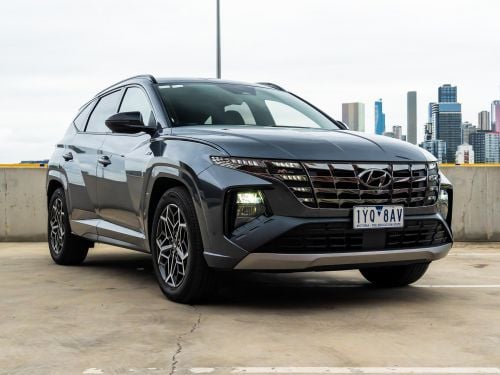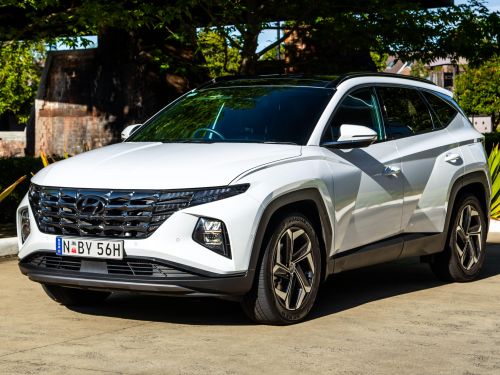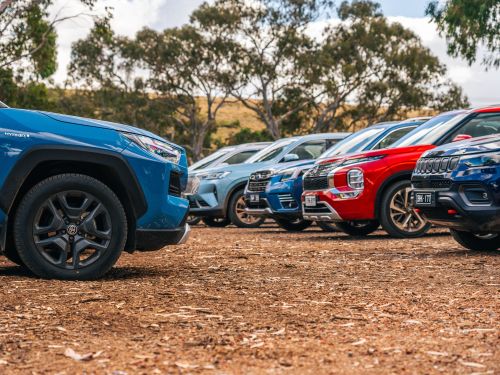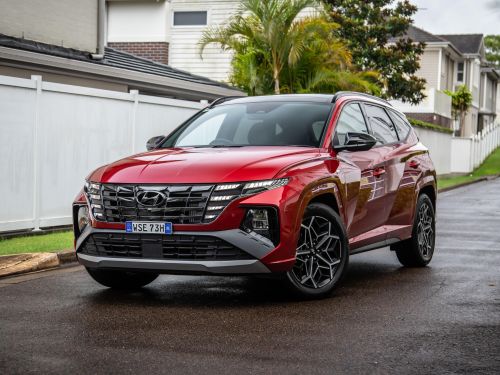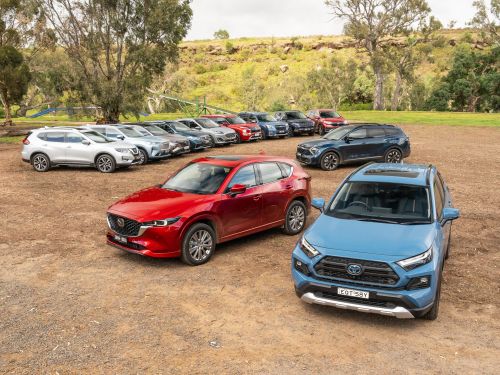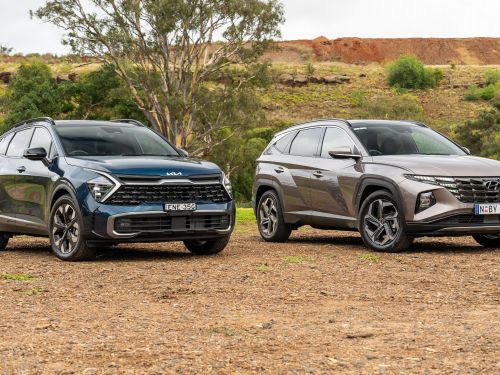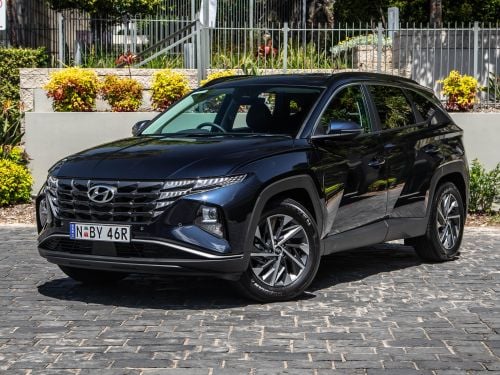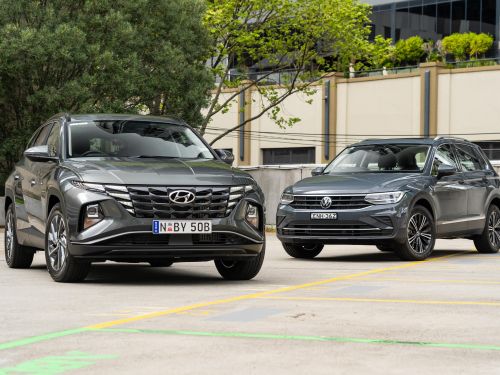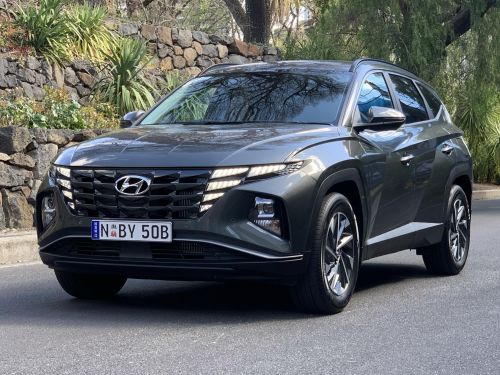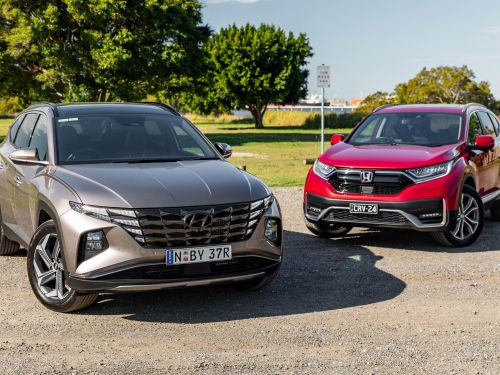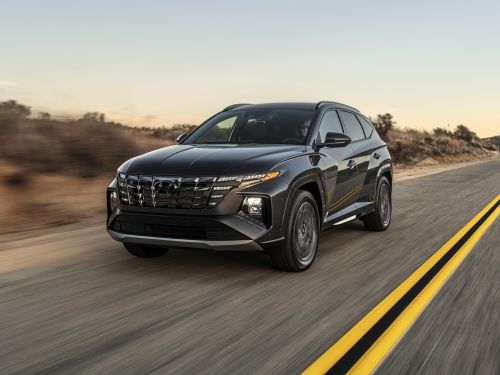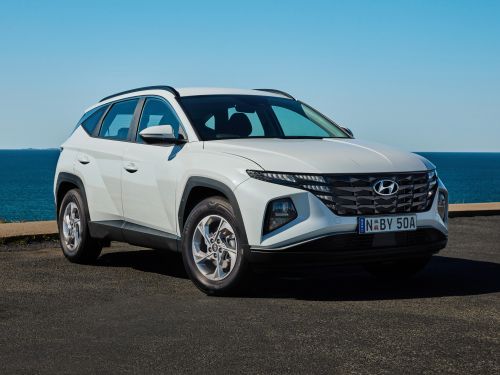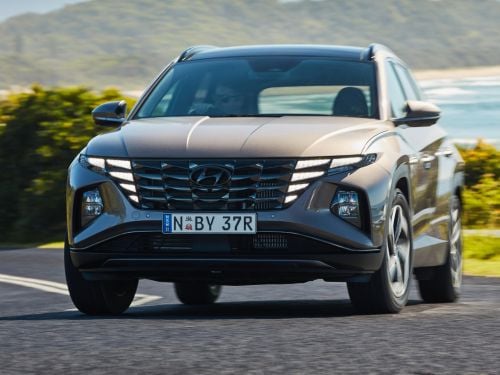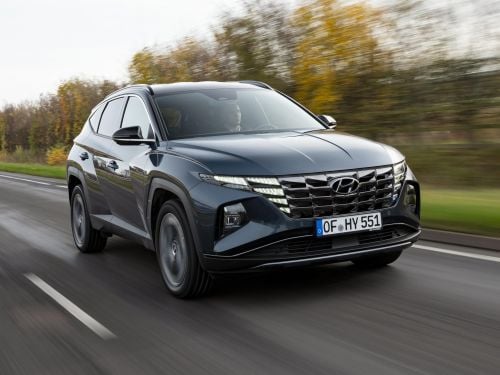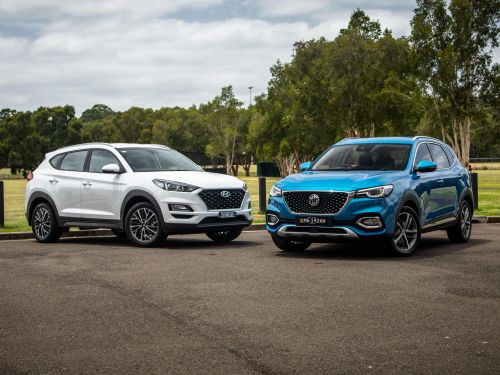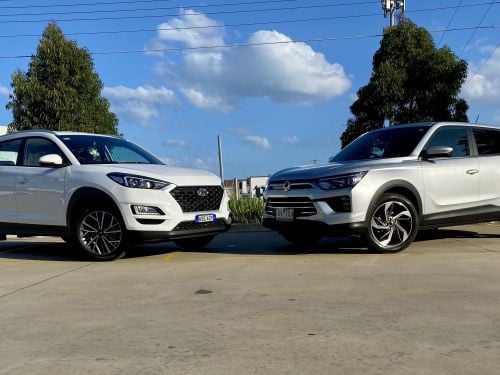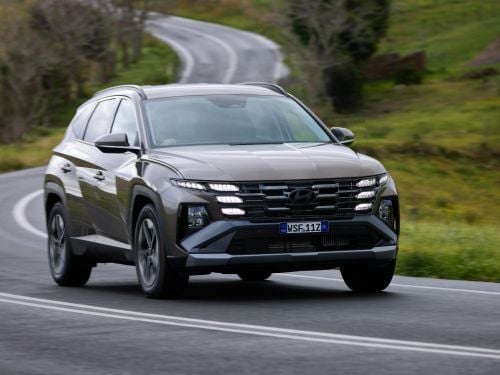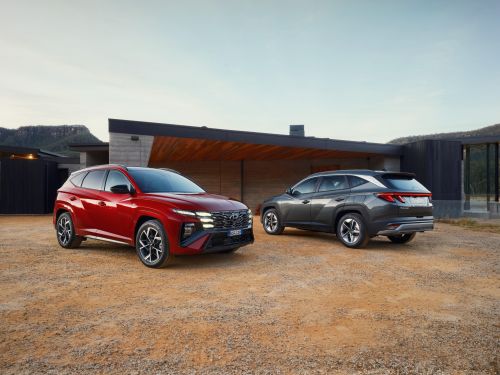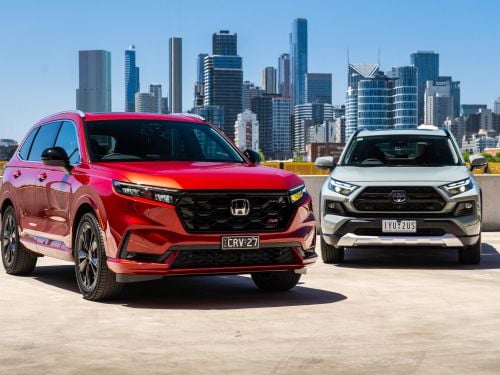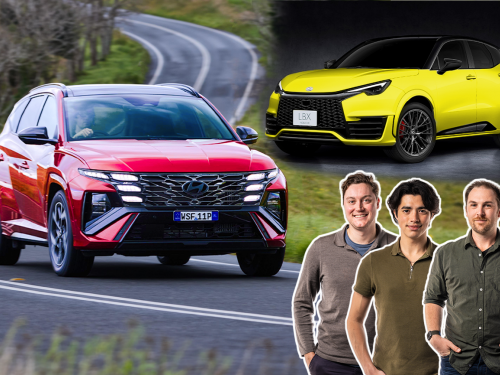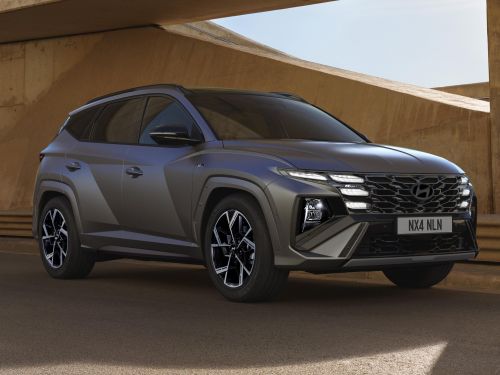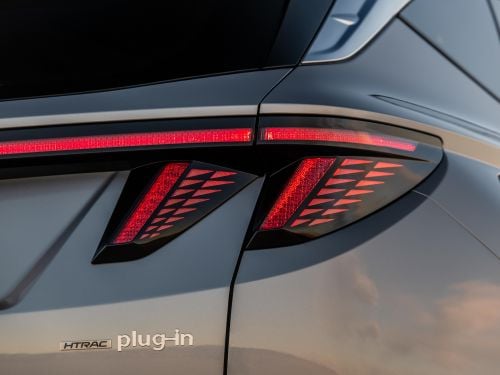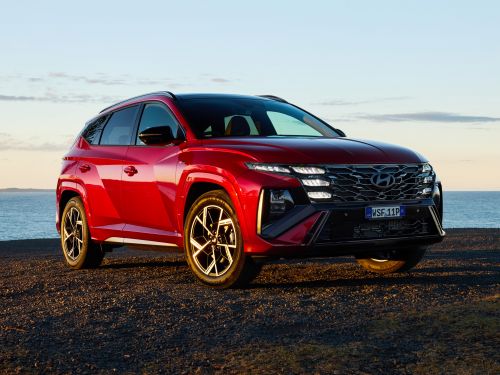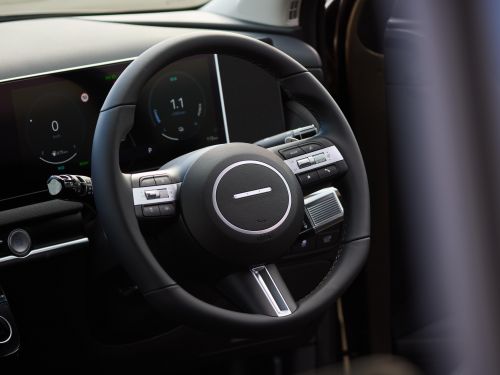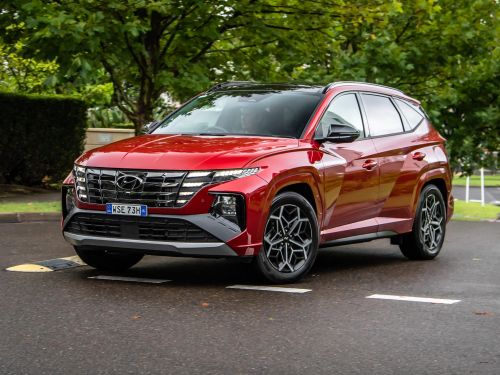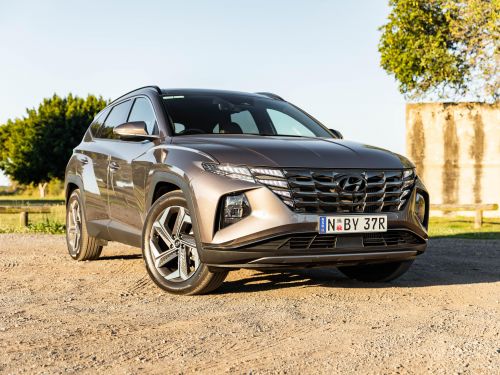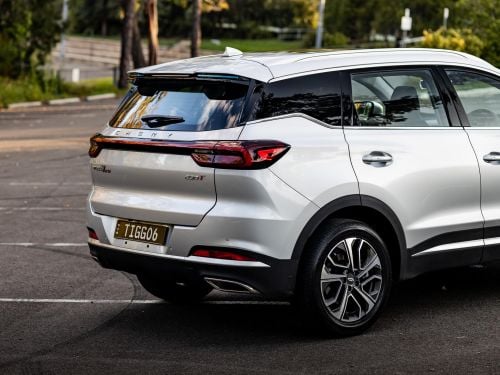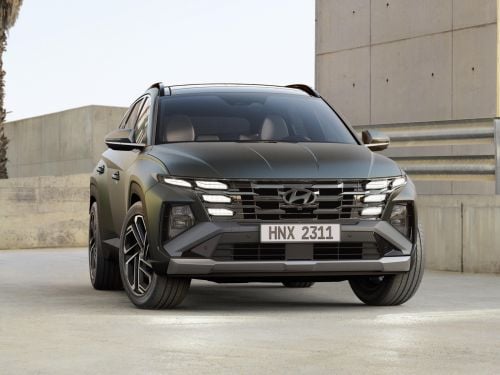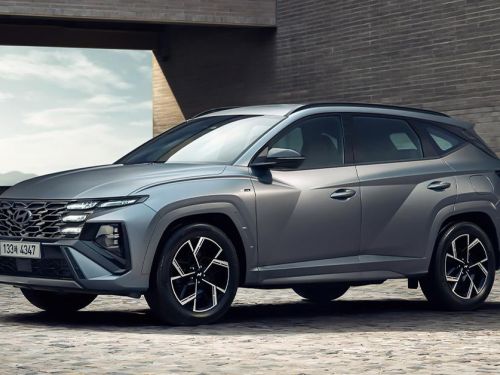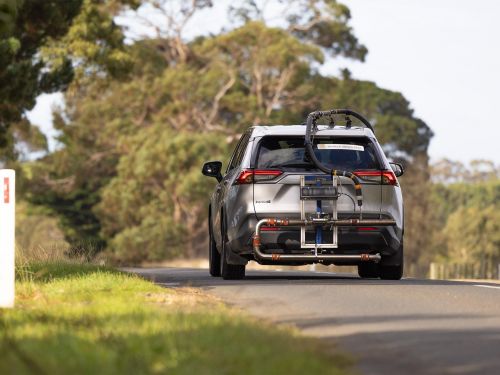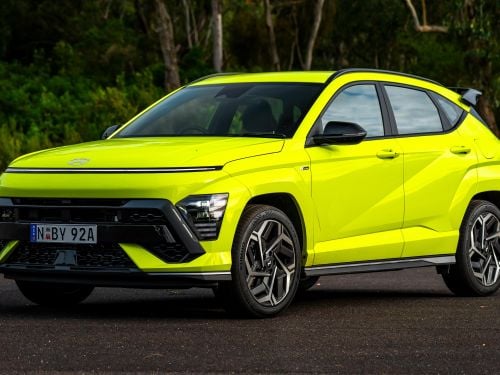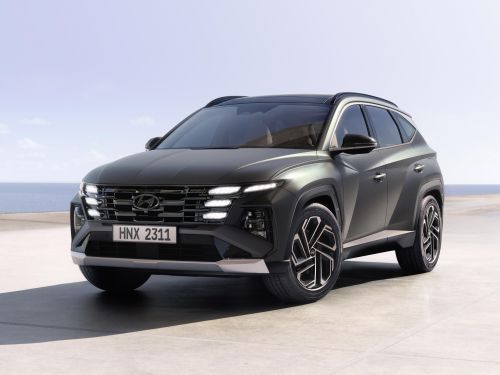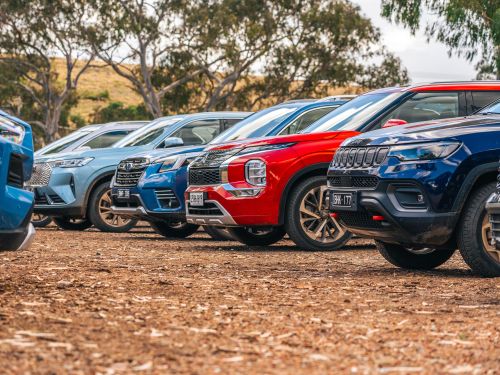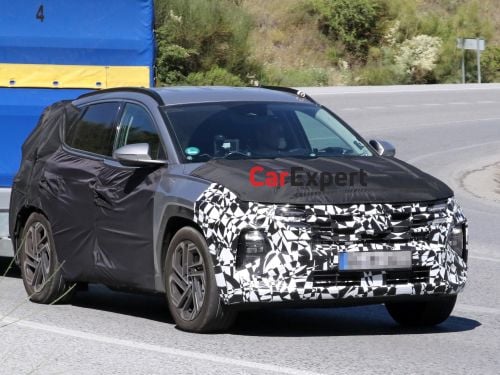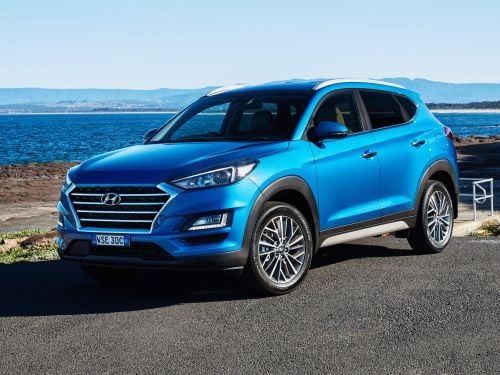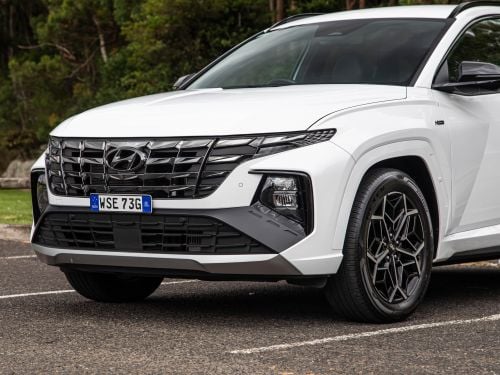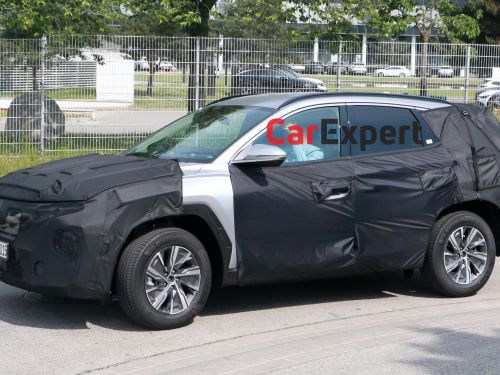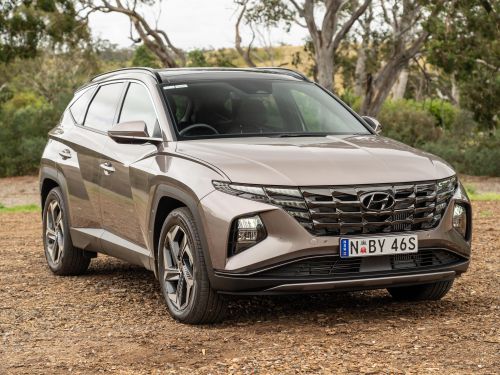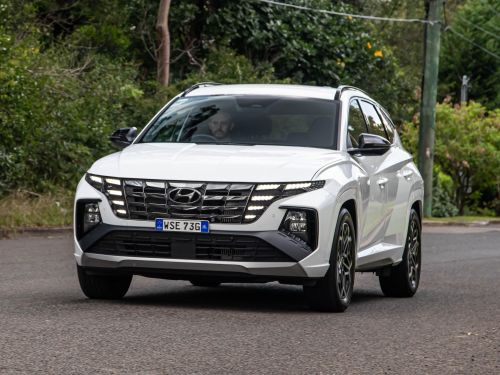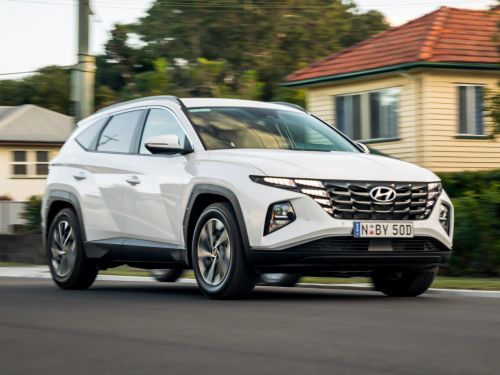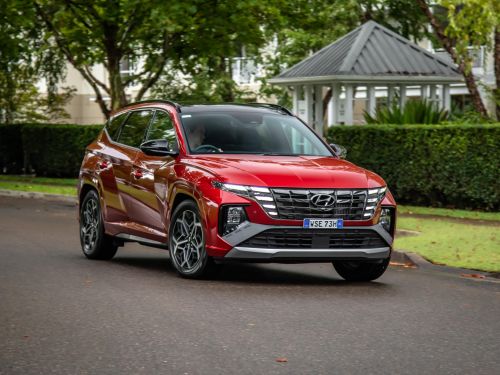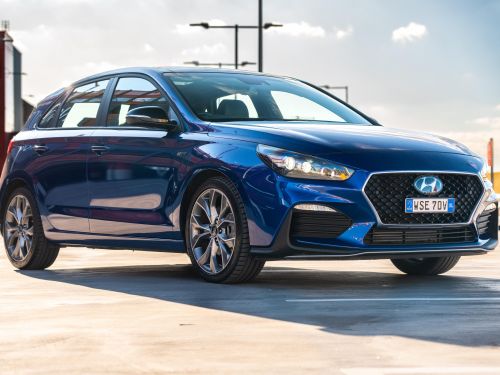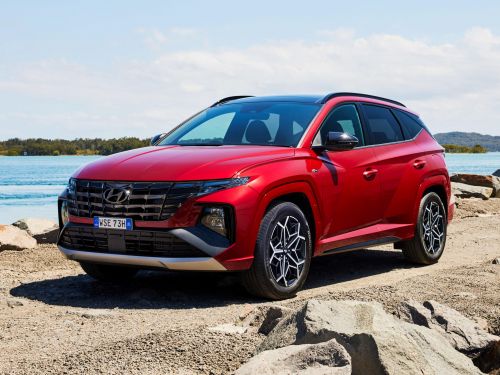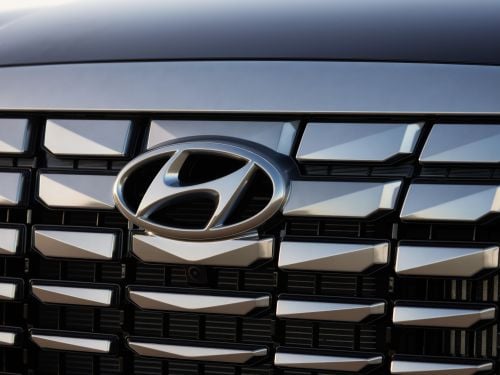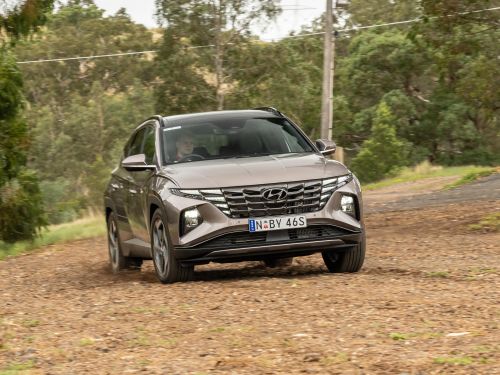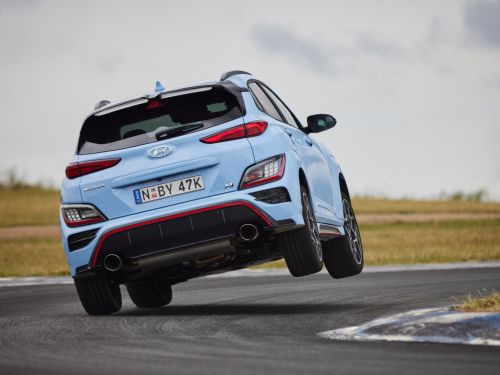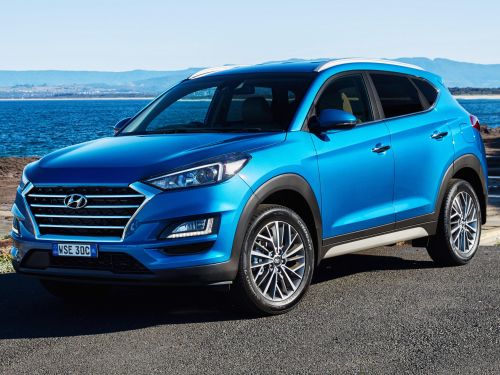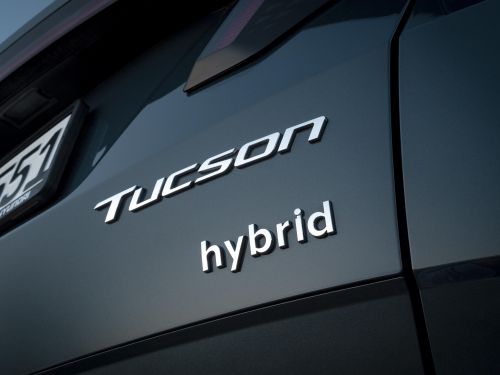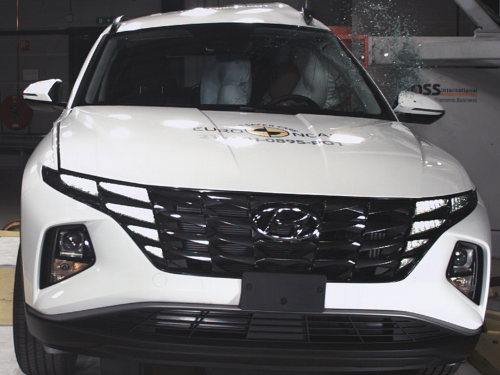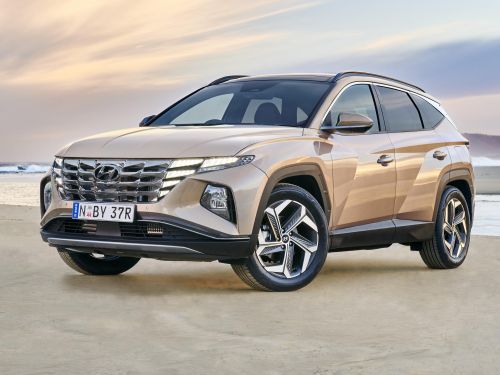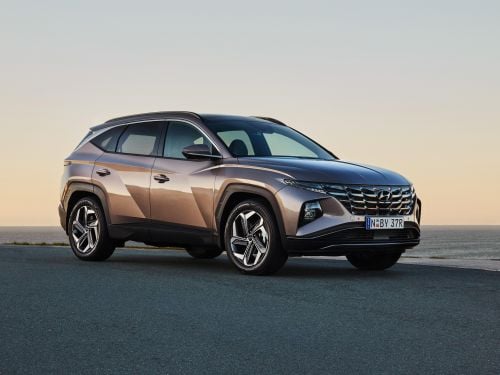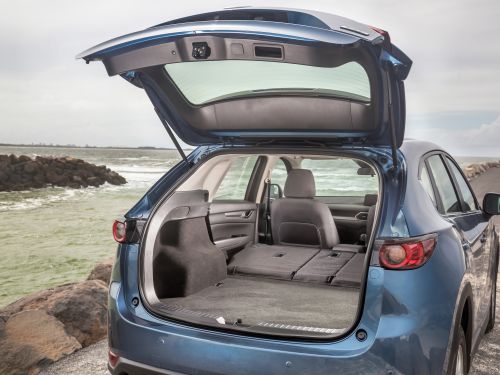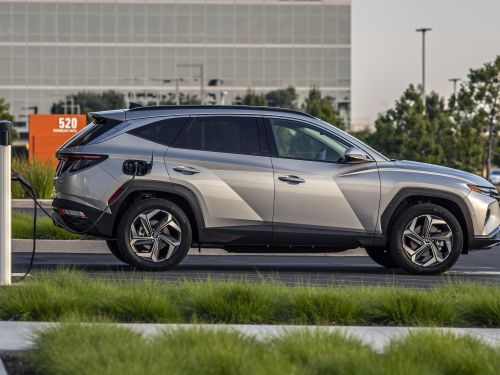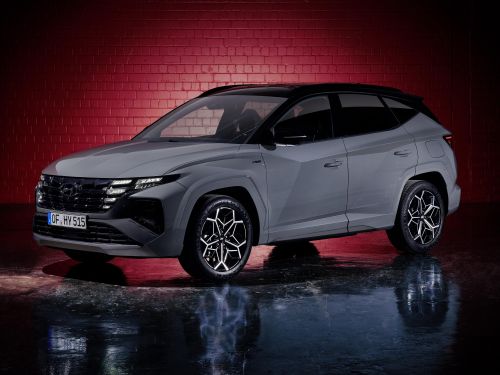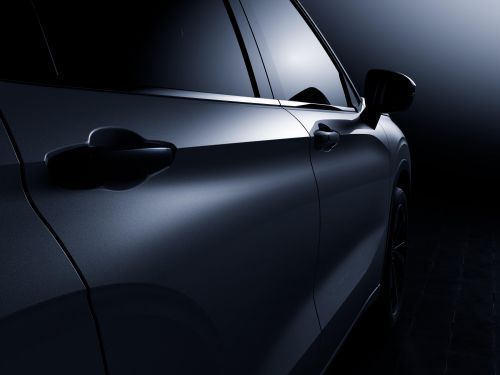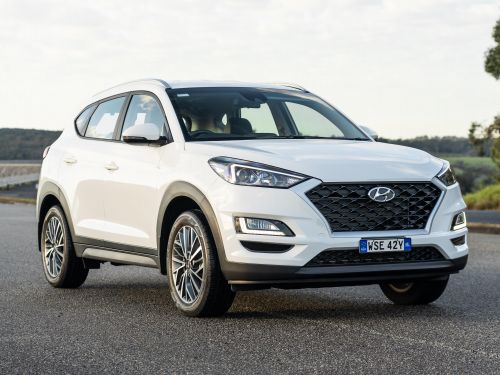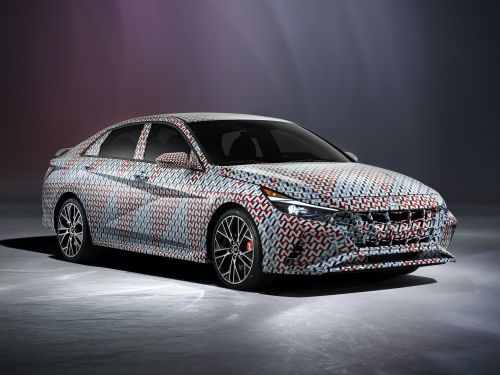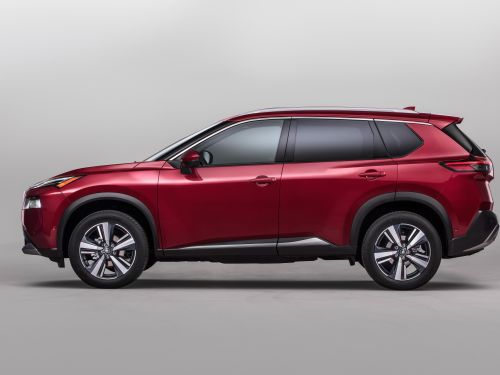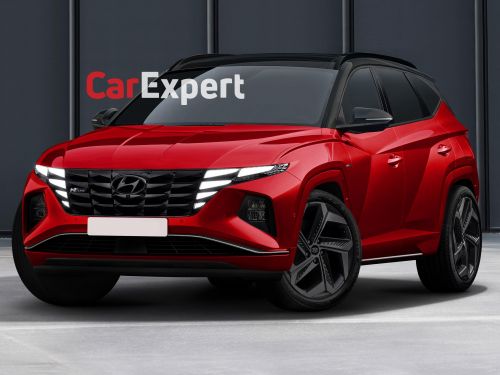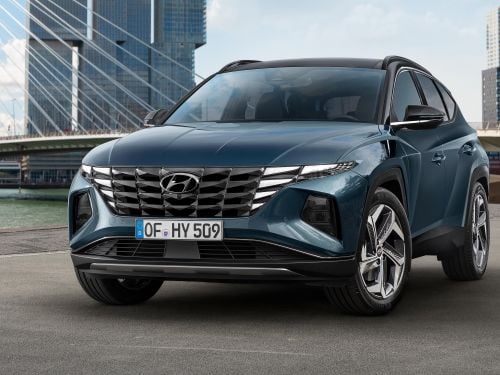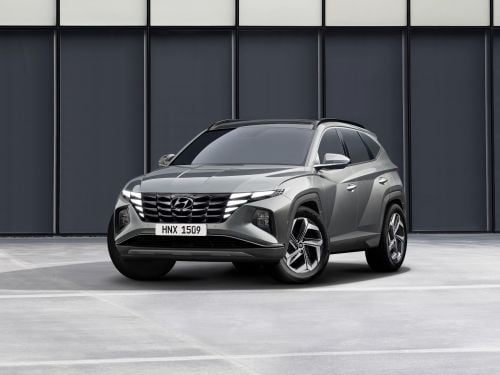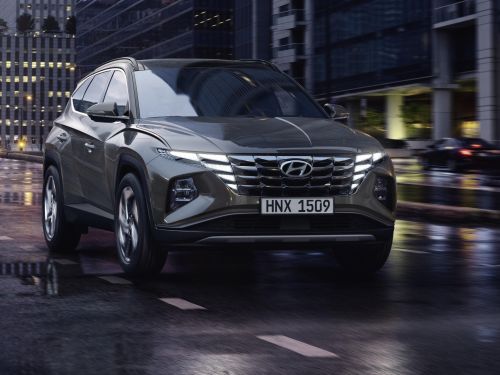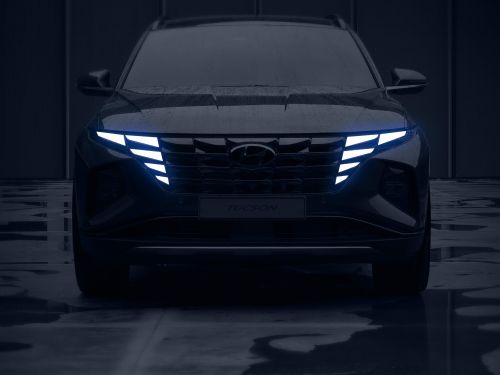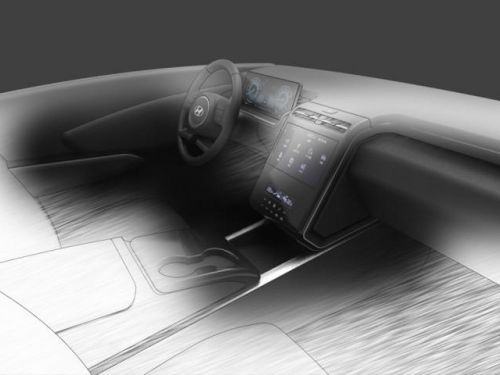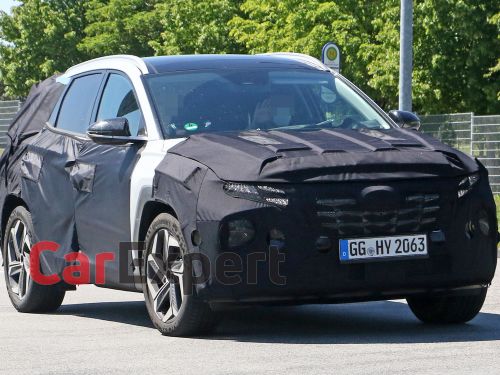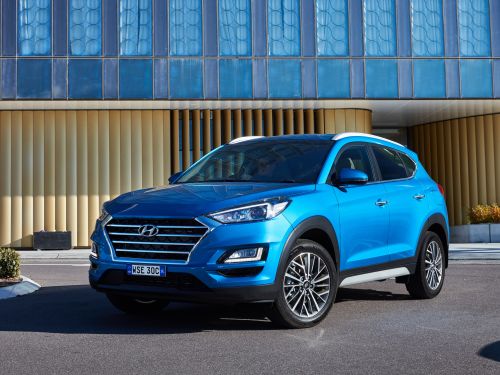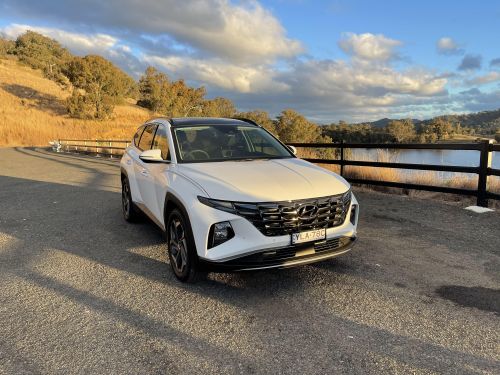
Hyundai Tucson
About the Hyundai Tucson
Last updated Aug 19, 2024The majority of the Hyundai Tucson line-up have received a range of connectivity features for the 2023 model year.
Hyundai Tucson Elite and Highlander variants now receive a complimentary five-year subscription to the company’s Bluelink connected services suite. Pricing for these models are up $500.
The mid-sized Tucson SUV also picks up services like automatic collision notification, SOS emergency calling and natural voice control in all bar the base model.
Other features include cloud-based navigation, weather and voice recognition, as well as the ability to send a destination to the car via the Hyundai Bluelink smartphone app.
You can also use the app to remotely check the vehicle’s status and location and lock, unlock and start the car, as well as adjust climate control settings.
Video Review
Skip to chapter
FULL review of the new Hyundai Tucson hybrid inc. 0-100 & braking! Finally better than RAV4?
Hyundai FINALLY has a hybrid version of the Tucson on sale. While the price has increased, the tech is now much better and it's finally a viable alternative to the Toyota RAV4 Hybrid. Is it any good? Paul Maric reviews the top-spec Hyundai Tucson Hybrid to find out.
Summary
Available, torquey turbo-diesel
Stylish, spacious interior
Impressive safety credentials
Disappointing base engine
Styling polarises
Too many touch-capacitive controls
Price & Specs
Reviews
News
Hyundai Tucson Range Guide
The base Tucson comes standard with the following features:
- 8.0-inch touchscreen infotainment system with Android Auto and Apple CarPlay
- 4.2-inch instrument cluster display screen
- 17-inch alloy wheels
- Leather-wrapped steering wheel and shifter
- Autonomous emergency braking with junction assist
- Tyre-pressure monitoring
- Halogen headlights with LED daytime running lights
- Automatic headlights
- Grey/black cloth upholstery
- Full-size spare wheel
- Remote folding second-row seats
- Driver’s seat power lumbar
The Tucson Elite adds:
- 10.25-inch touchscreen infotainment system with Android Auto, Apple CarPlay and satellite navigation
- 18-inch alloy wheels
- 10-way power driver’s seat
- Heated front seats
- Dual-zone climate control
- Front parking sensors
- Keyless entry and start
- Black leather upholstery
- Rain-sensing wipers
- Rear privacy glass
- Paddle shifters (excludes 2.0-litre petrol)
- Rear seat radar occupant alert
The Tucson Highlander adds:
- 10.25-inch digital instrument cluster
- 19-inch alloy wheels
- Remote smart parking assist (diesel only)
- Bose premium sound system
- Surround-view camera
- Blind-spot view monitor
- Power tailgate
- Heated and ventilated front seats
- Heated rear seats
- Heated steering wheel
- Eight-way power passenger seat
- LED headlights and tail lights
- Ambient lighting
- Electro-chromatic rear-view mirror
- Passenger walk-in device
- Silver-painted skid plate
- Choice of black, brown or light grey interior colours
The N Line package adds:
- 19-inch alloy wheels
- 10.25-inch digital instrument cluster (Tucson, Elite)
- Sports seats
- LED headlights and tail lights (Tucson, Elite)
- Leather and suede upholstery
- N Line steering wheel
- Black interior with black headliner
- Metal pedals
Compare









Interior
While the Tucson’s exterior may be full of creases and unusual shapes, the interior is refreshingly clean and rather upscale in its execution.
The dashboard has a dual-cowl design with a flowing centre stack, emboldened by Hyundai’s use of touch-capacitive controls. This gives the Tucson’s dash an elegant appearance, however these controls lack haptic feedback and are prone to smudges.






If you don’t like gloss black trim, you may bristle at the sight of the Tucson’s dash.
The base and Elite grades’ analogue instruments are rather chintzy in appearance, if bracketing a useful 4.2-inch display, but the digital instrument cluster that comes on the Highlander and models with the N Line package is more aesthetically pleasing.
There are other neat touches, like upholstered inserts on the dash and ambient lighting in the Highlander that changes colour based on your drive mode.
The touchscreen infotainment system is slick and responsive in Hyundai fashion. However, also in Hyundai fashion, it frustratingly lacks wireless smartphone connectivity in all bar the base model.
Hyundai doesn’t offer its 10.25-inch touchscreen with both factory satellite navigation and wireless smartphone mirroring, though the latter is available with the smaller 8.0-inch screen – but not the former. Even if you step up to a model with the 10.25-inch screen, by the way, Android Auto doesn’t take up the full screen.
The steering wheel is rather unusual looking but it feels good in your hands. There’s a voice prompt button on the steering wheel but, unlike in the Honda, this will work only with smartphone mirroring and doesn’t interact at all with the core system.
At the base of the centre stack, you’ll find a wireless charging pad, a 12V outlet and two USB-A outlets.
The Highlander and all-wheel drive Elite models are unique in featuring a push-button transmission shifter, which sits on a centre console that rises up like a bridge and features handy storage underneath.
Comfort and space up front is top notch. The front chairs are cushy but supportive, with a wide range of adjustment and good bolstering to ensure your thighs and lower back are well supported over longer stints.
The Tucson’s wheelbase is 85mm longer than that of its predecessor, and nowhere is that more apparent than the back seat and the boot. Neither was disappointingly small in the old Tucson, but in the new car both areas are utterly capacious.
There are rear air vents but no separate climate controls, two USB charge ports, as well as map pockets, bottle holders in the doors and a fold-down centre armrest with cupholders. ISOFIX mounts on the outboard seats also mean the youngest of family members are catered for.
For maximum comfort you can recline the rear seatbacks, but they don’t slide like they do in a Volkswagen Tiguan.






























Exterior
The base and Elite grades stick with halogen headlights and incandescent tail lights, though you can opt for the N Line package to be rid of this outmoded lighting technology.
Likewise, Highlander models feature LED lighting front and rear.




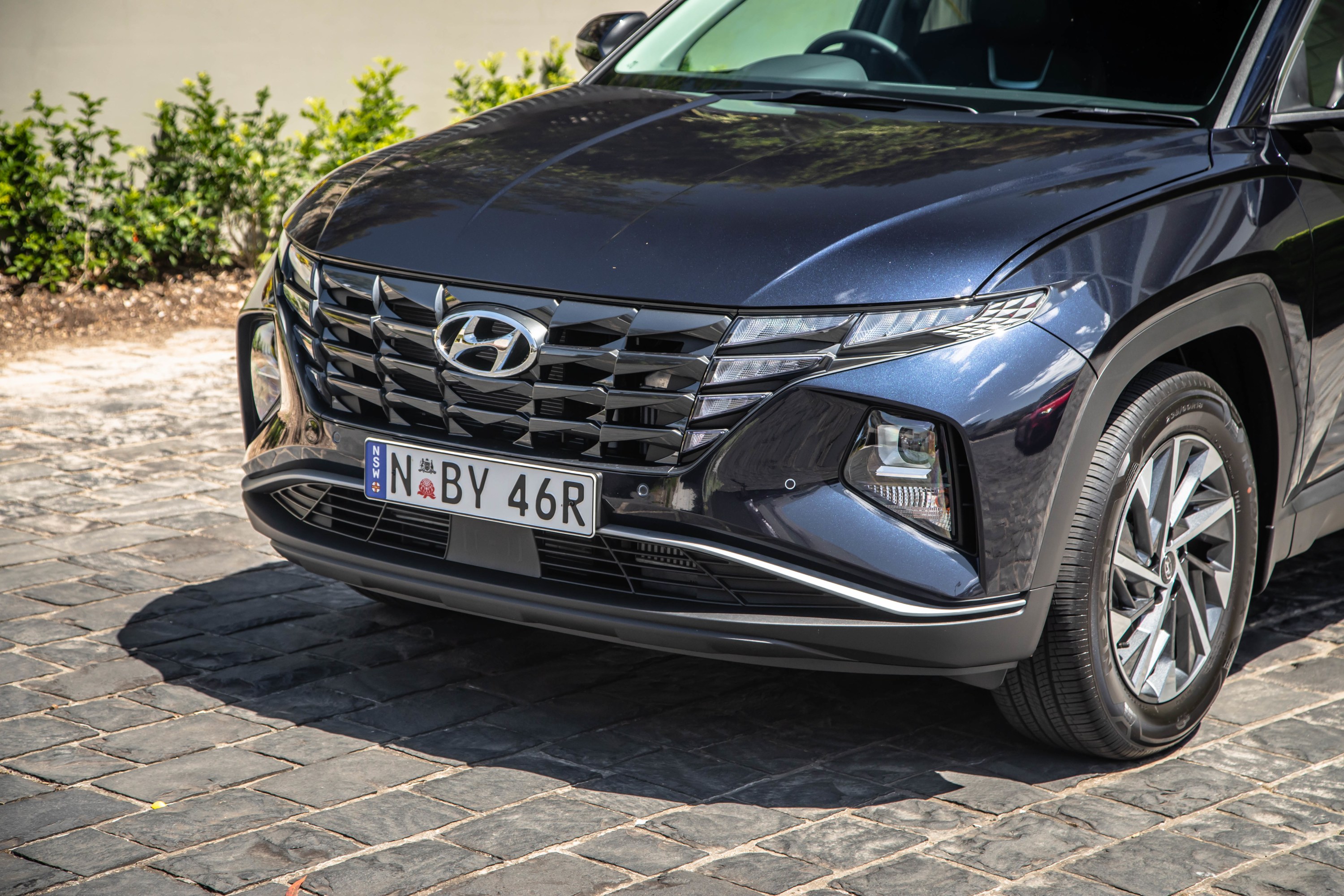

N Line models feature an exterior appearance package that gives them a sporty look, plus a unique 19-inch alloy wheel design. The Highlander also runs on 19s, while the base and Elite feature 17- and 18-inch alloys, respectively.




















Hyundai Tucson Photo Gallery



















































Hyundai Tucson Colours
White Cream is the standard paint colour, with all other finishes costing an extra $595. The palette comprises:
- Titan Grey
- Shimmering Silver
- Phantom Black
- Deep Sea
- Amazon Grey (excludes base model)
- Silky Bronze (Highlander only)







N Line models are available only in:
- Crimson Red
- White Cream
- Phantom Black
- Titan Grey
Cost of Ownership
The Tucson is covered by a five-year, unlimited-kilometre warranty.
Servicing is required every 12 months or 15,000km, whichever comes first. The exception is 1.6T models, for which intervals are 12 months/10,000km.
The first five services are capped at $319 each in petrol models and $375 each in the diesel.
How it Drives
While the Tucson doesn’t have a local ride and handling tune, its combination of pliant ride and neutral handling mean it stacks up well, dynamically, against key rivals.
The suspension is quiet and there’s not much tyre or wind noise out on the open road. In terms of overall polish, it’s the sort of quality you pay handsomely for in premium-badged machinery. The steering is also crisp, light and direct – it’s an easy thing to commute about in.


The cabin is nicely insulated from the outside world, the new platform from the larger Santa Fe brings a big-car feel to a more compact package, and the driver controls are light and fluid without lacking too much in feedback.
The combination of Lane Following Assist and adaptive cruise control makes the Tucson a breeze to drive on the highway. Such is the cleverness of these systems, you’d be forgiven for thinking the car could just drive itself for hundreds of kilometres.
However, take your hands off the wheel for more than a few seconds and the system will quickly chide you. The lane-keep assist, which defaults to ‘on’ upon startup, is less assertive but still makes its presence felt, which mightn’t be to your tastes.
The available all-wheel drive system is a bit more reactive than proactive, and you can encounter some wheelspin when you’re too eager to turn at a junction from a standstill.
The three powertrains are very different from each other. Let’s start with the least impressive: the base naturally-aspirated 2.0-litre petrol four-cylinder.
Outputs are nothing to write home about and it feels lacking in verve on the road, while it sounds gruff when accelerating. The six-speed torque-converter automatic transmission also isn’t anything to write home about, with some slurring shifts.
The turbocharged 1.6-litre petrol uses a seven-speed dual-clutch automatic transmission but it’s one of the smoother dual-clutch units out there with little in the way of hesitation from a standing start.
This engine also has a more pleasant soundtrack than most Hyundais with a four-banger, which often sound coarse. However, it’s no match for a turbo-petrol CX-5 or a Volkswagen Tiguan 162TSI – while this engine feels punchy in smaller Hyundais, it’s less exciting in the heavier Tucson.
The diesel is arguably the best.
There’s virtually no diesel rattle, and the engine is extremely smooth and refined with oodles of torque. It’s also mated with a well-calibrated eight-speed torque-converter automatic transmission.
Hyundai Tucson Safety Rating
The Tucson has one of the most comprehensive safety suites in this segment.

Standard equipment across the range includes:
- AEB with pedestrian and cyclist detection and junction assist
- Blind-spot assist
- Rear cross-traffic assist
- Lane-keep assist
- Lane Following Assist
- Adaptive cruise control with stop/go
- Reversing camera with rear parking sensors
- Leading vehicle departure alert
- Rear occupant alert
- Driver attention monitoring
- Intelligent speed limit assist
- Safe exit warning
The Elite adds a radar-based rear occupant alert and front parking sensors, while the Highlander includes the Blind-Spot View Monitor, a surround-view camera, and reverse AEB.
Models with LED headlights also include automatic high-beam.
Hyundai Tucson Options
The only option on the Tucson range is the N Line package, which costs between $1500 and $4000 depending on the variant.
N Line option pack
- Tucson: $4000
- Elite: $2500
- Highlander: $1500
It adds:
- 19-inch alloy wheels
- 10.25-inch digital instrument cluster (Tucson, Elite)
- Sports seats
- LED headlights and tail lights (Tucson, Elite)
- Leather and suede upholstery
- N Line steering wheel
- Black interior with black headliner
- Metal pedals
Hyundai Tucson Warranty
The 2023 Hyundai Tucson is covered by a five-year, unlimited kilometre warranty with five years of capped-price servicing.
Hyundai Tucson Stock Availability
Hyundai said there's constant supply of the Tucson and stock on the ground, though it said waiting times will vary from model to model.
Hyundai Tucson Infotainment
The base model comes with an 8-inch touchscreen infotainment system coupled to a 4.2-inch digital instrument cluster. Nonetheless, it still offers Wireless Apple CarPlay and Android Auto with wireless phone charging. The audio is pumped through a six-speaker sound system.
Upgrade to the Elite and you actually lose wireless CarPlay and Android Auto but you do get a bigger 10.25-inch touchscreen infotainment system that comes with built in Satellite navigation


The top-spec Highlander keeps the 10.25-inch digital instrument cluster but gets the upgrade to the full Bose premium sound system.








Hyundai Tucson Boot Space
The boot area holds 539L with the rear seats up, and 1860L with them folded. It’s up there with the best in class, and the area itself is deep with a pretty flat boot floor.
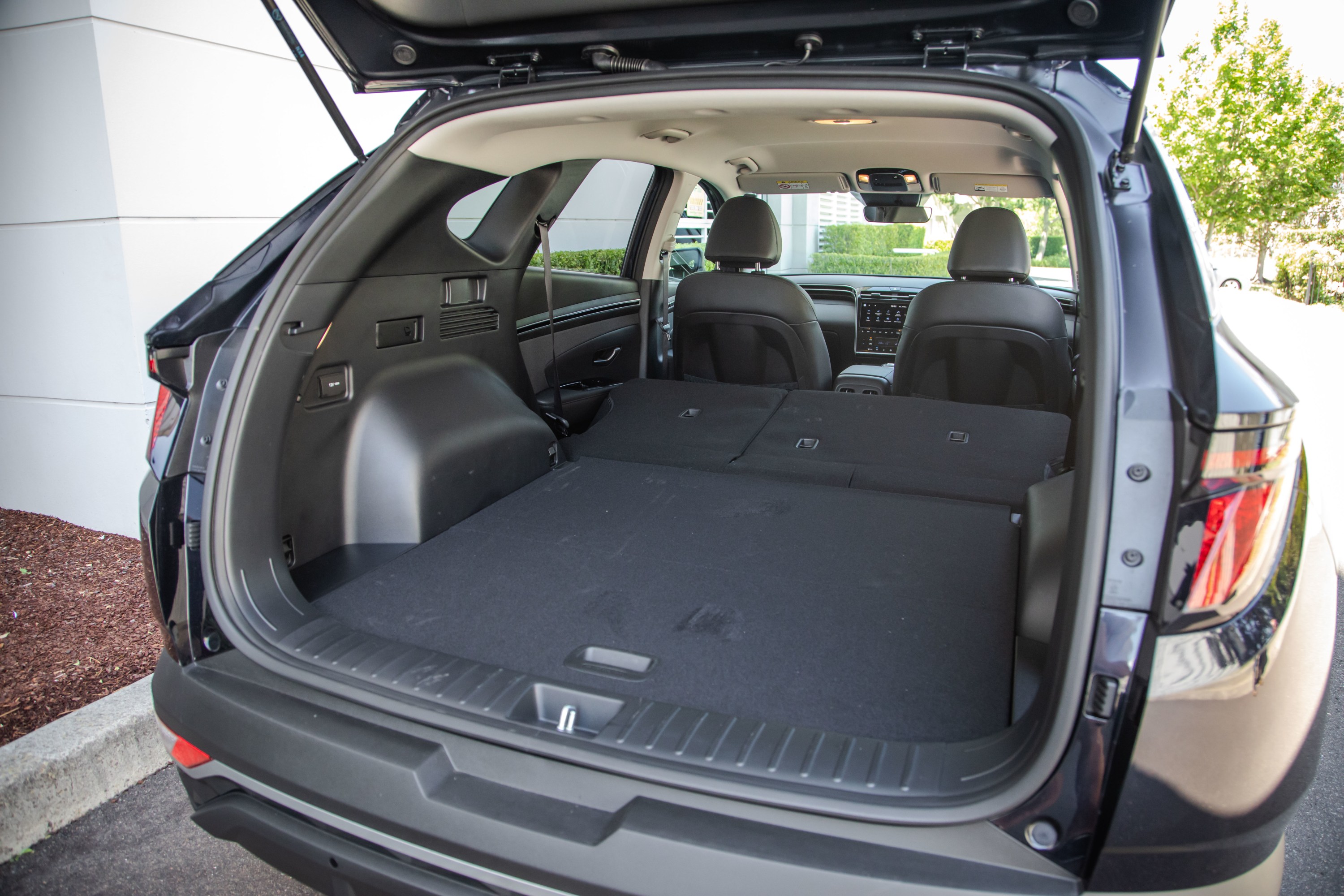


There’s a full-size alloy spare wheel under the floor, which is becoming a rarity.




Hyundai Tucson Fuel Economy
The Tucson uses 8.1L/100km on the combined cycle with the base 2.0-litre engine, 7.2L/100km with the optional turbo 1.6-litre, and 6.3L/100km with the turbo-diesel.
Petrol models require only 91 RON regular unleaded fuel, while all models have a 54L fuel tank.
Depending on the variant, view the 2024 HYUNDAI TUCSON fuel usage below.
All Highway, City, and Combined figures below are litres per 100km
| Variant | Series | Style | Fuel Type | Highway | City | Combined | E10? |
|---|---|---|---|---|---|---|---|
| (FWD) | NX4.V3 MY25 | 4D WAGON | UNLEADED PETROL | - | - | 8.1 | Yes |
| N LINE (FWD) | NX4.V2 MY24 | 4D WAGON | UNLEADED PETROL | - | - | 8.1 | Yes |
| ELITE (FWD) | NX4.V3 MY25 | 4D WAGON | UNLEADED PETROL | - | - | 8.1 | Yes |
| N LINE (FWD) | NX4.V3 MY25 | 4D WAGON | UNLEADED PETROL | - | - | 6.7 | Yes |
| HYBRID (FWD) | NX4.V3 MY25 UPDATE | 4D WAGON | UNLEADED PETROL/ELECTRIC | - | - | 5.3 | Yes |
| ELITE (FWD) | NX4.V3 MY25 | 4D WAGON | UNLEADED PETROL | - | - | 6.7 | Yes |
| HIGHLANDER (FWD) NO SRF | NX4.V2 MY24 | 4D WAGON | UNLEADED PETROL | - | - | 8.1 | Yes |
| ELITE (AWD) | NX4.V2 MY24 | 4D WAGON | DIESEL | - | - | 6.3 | - |
| HIGHLANDER N LINE (FWD) NO SRF | NX4.V2 MY24 | 4D WAGON | UNLEADED PETROL | - | - | 8.1 | Yes |
| HIGHLANDER (FWD) | NX4.V2 MY24 | 4D WAGON | UNLEADED PETROL | - | - | 8.1 | Yes |
| ELITE (AWD) | NX4.V3 MY25 | 4D WAGON | UNLEADED PETROL | - | - | 7.2 | Yes |
| ELITE N LINE (FWD) | NX4.V3 MY25 | 4D WAGON | UNLEADED PETROL | - | - | 6.7 | Yes |
| HYBRID N LINE (FWD) | NX4.V3 MY25 UPDATE | 4D WAGON | UNLEADED PETROL/ELECTRIC | - | - | 5.3 | Yes |
| HIGHLANDER N LINE (FWD) | NX4.V2 MY24 | 4D WAGON | UNLEADED PETROL | - | - | 8.1 | Yes |
| ELITE N LINE (AWD) | NX4.V2 MY24 | 4D WAGON | DIESEL | - | - | 6.3 | - |
| ELITE HYBRID (FWD) | NX4.V3 MY25 UPDATE | 4D WAGON | UNLEADED PETROL/ELECTRIC | - | - | 5.3 | Yes |
| HIGHLANDER (AWD) NO SRF | NX4.V2 MY24 | 4D WAGON | UNLEADED PETROL | - | - | 7.2 | Yes |
| ELITE N LINE (AWD) | NX4.V3 MY25 | 4D WAGON | UNLEADED PETROL | - | - | 7.2 | Yes |
| HIGHLANDER (AWD) | NX4.V2 MY24 | 4D WAGON | UNLEADED PETROL | - | - | 7.2 | Yes |
| HIGHLANDER N LINE (AWD) NO SRF | NX4.V2 MY24 | 4D WAGON | UNLEADED PETROL | - | - | 7.2 | Yes |
| HIGHLANDER (AWD) NO SRF | NX4.V2 MY24 | 4D WAGON | DIESEL | - | - | 6.3 | - |
| ELITE HYBRID (AWD) | NX4.V3 MY25 UPDATE | 4D WAGON | UNLEADED PETROL/ELECTRIC | - | - | 5.3 | Yes |
| ELITE HYBRID N LINE (FWD) | NX4.V3 MY25 UPDATE | 4D WAGON | UNLEADED PETROL/ELECTRIC | - | - | 5.3 | Yes |
| HIGHLANDER N LINE (AWD) | NX4.V2 MY24 | 4D WAGON | UNLEADED PETROL | - | - | 7.2 | Yes |
| HIGHLANDER N LINE (AWD) NO SRF | NX4.V2 MY24 | 4D WAGON | DIESEL | - | - | 6.3 | - |
| HIGHLANDER (AWD) | NX4.V2 MY24 | 4D WAGON | DIESEL | - | - | 6.3 | - |
| ELITE HYBRID N LINE (AWD) | NX4.V3 MY25 UPDATE | 4D WAGON | UNLEADED PETROL/ELECTRIC | - | - | 5.3 | Yes |
| HIGHLANDER N LINE (AWD) | NX4.V2 MY24 | 4D WAGON | DIESEL | - | - | 6.3 | - |
| PREMIUM (AWD) | NX4.V3 MY25 | 4D WAGON | UNLEADED PETROL | - | - | 7.2 | Yes |
| PREMIUM N LINE (AWD) | NX4.V3 MY25 | 4D WAGON | UNLEADED PETROL | - | - | 7.2 | Yes |
| PREMIUM HYBRID (AWD) | NX4.V3 MY25 UPDATE | 4D WAGON | UNLEADED PETROL/ELECTRIC | - | - | 5.3 | Yes |
| PREMIUM N LINE HYBRID (AWD) | NX4.V3 MY25 UPDATE | 4D WAGON | UNLEADED PETROL/ELECTRIC | - | - | 5.3 | Yes |
Hyundai Tucson Dimensions
The Tucson measures up at 4630mm long, 1865mm wide, and 1665mm tall with a 2755mm wheelbase.
Kerb weight ranges from 1428kg with the 2.0-litre to up to 1810kg when equipped with the turbo-diesel engine and all-wheel drive.
Depending on the variant, the 2024 HYUNDAI TUCSON measures as below.
| Variant | Series | Style | Length (mm) | Width (mm) | Height (mm) | Wheelbase (mm) |
|---|---|---|---|---|---|---|
| (FWD) | NX4.V3 MY25 | 4D WAGON | 4640 | 1865 | 1665 | 2755 |
| N LINE (FWD) | NX4.V2 MY24 | 4D WAGON | 4640 | 1865 | 1665 | 2755 |
| ELITE (FWD) | NX4.V3 MY25 | 4D WAGON | 4640 | 1865 | 1665 | 2755 |
| N LINE (FWD) | NX4.V3 MY25 | 4D WAGON | 4650 | 1865 | 1665 | 2755 |
| HYBRID (FWD) | NX4.V3 MY25 UPDATE | 4D WAGON | 4640 | 1865 | 1665 | 2755 |
| ELITE (FWD) | NX4.V3 MY25 | 4D WAGON | 4640 | 1865 | 1665 | 2755 |
| HIGHLANDER (FWD) NO SRF | NX4.V2 MY24 | 4D WAGON | 4630 | 1865 | 1665 | 2755 |
| ELITE (AWD) | NX4.V2 MY24 | 4D WAGON | 4630 | 1865 | 1665 | 2755 |
| HIGHLANDER N LINE (FWD) NO SRF | NX4.V2 MY24 | 4D WAGON | 4640 | 1865 | 1665 | 2755 |
| HIGHLANDER (FWD) | NX4.V2 MY24 | 4D WAGON | 4630 | 1865 | 1665 | 2755 |
| ELITE (AWD) | NX4.V3 MY25 | 4D WAGON | 4640 | 1865 | 1665 | 2755 |
| ELITE N LINE (FWD) | NX4.V3 MY25 | 4D WAGON | 4650 | 1865 | 1665 | 2755 |
| HYBRID N LINE (FWD) | NX4.V3 MY25 UPDATE | 4D WAGON | 4650 | 1865 | 1665 | 2755 |
| HIGHLANDER N LINE (FWD) | NX4.V2 MY24 | 4D WAGON | 4640 | 1865 | 1665 | 2755 |
| ELITE N LINE (AWD) | NX4.V2 MY24 | 4D WAGON | 4640 | 1865 | 1665 | 2755 |
| ELITE HYBRID (FWD) | NX4.V3 MY25 UPDATE | 4D WAGON | 4640 | 1865 | 1665 | 2755 |
| HIGHLANDER (AWD) NO SRF | NX4.V2 MY24 | 4D WAGON | 4630 | 1865 | 1665 | 2755 |
| ELITE N LINE (AWD) | NX4.V3 MY25 | 4D WAGON | 4650 | 1865 | 1665 | 2755 |
| HIGHLANDER (AWD) | NX4.V2 MY24 | 4D WAGON | 4630 | 1865 | 1665 | 2755 |
| HIGHLANDER N LINE (AWD) NO SRF | NX4.V2 MY24 | 4D WAGON | 4640 | 1865 | 1665 | 2755 |
| HIGHLANDER (AWD) NO SRF | NX4.V2 MY24 | 4D WAGON | 4630 | 1865 | 1665 | 2755 |
| ELITE HYBRID (AWD) | NX4.V3 MY25 UPDATE | 4D WAGON | 4640 | 1865 | 1665 | 2755 |
| ELITE HYBRID N LINE (FWD) | NX4.V3 MY25 UPDATE | 4D WAGON | 4650 | 1865 | 1665 | 2755 |
| HIGHLANDER N LINE (AWD) | NX4.V2 MY24 | 4D WAGON | 4640 | 1865 | 1665 | 2755 |
| HIGHLANDER N LINE (AWD) NO SRF | NX4.V2 MY24 | 4D WAGON | 4640 | 1865 | 1665 | 2755 |
| HIGHLANDER (AWD) | NX4.V2 MY24 | 4D WAGON | 4630 | 1865 | 1665 | 2755 |
| ELITE HYBRID N LINE (AWD) | NX4.V3 MY25 UPDATE | 4D WAGON | 4650 | 1865 | 1665 | 2755 |
| HIGHLANDER N LINE (AWD) | NX4.V2 MY24 | 4D WAGON | 4640 | 1865 | 1665 | 2755 |
| PREMIUM (AWD) | NX4.V3 MY25 | 4D WAGON | 4640 | 1865 | 1665 | 2755 |
| PREMIUM N LINE (AWD) | NX4.V3 MY25 | 4D WAGON | 4650 | 1865 | 1665 | 2755 |
| PREMIUM HYBRID (AWD) | NX4.V3 MY25 UPDATE | 4D WAGON | 4640 | 1865 | 1665 | 2755 |
| PREMIUM N LINE HYBRID (AWD) | NX4.V3 MY25 UPDATE | 4D WAGON | 4650 | 1865 | 1665 | 2755 |
The 2024 HYUNDAI TUCSON has a braked towing capacity from 1650kg to 1900kg depending on the variant and an unbraked towing capacity of 750kg.
Hyundai Tucson Market Fit
The Tucson and its corporate cousin, the Sportage, long ago entered the mainstream much as the rest of their brands' models did.
A new set of budget-brand challengers has emerged, with the Haval H6, MG HS and SsangYong Korando undercutting the Tucson.
As part of the establishment, the Tucson battles the likes of the Mazda CX-5, Mitsubishi Outlander, Nissan X-Trail, Subaru Forester and Toyota RAV4 directly.
Hyundai Tucson Sales Data
In 2023, Hyundai sold 21,224 Tucsons in Australia.
Should you buy the Hyundai Tucson
With its spacious cabin, nicely-appointed interior and long list of standard safety equipment, the Tucson should be on your shortlist if you're after a mid-sized SUV.
We'd recommend, however, you steer away from the base engine which feels underdone. The turbo-petrol and turbo-diesel engines are vastly superior.
Competitor Analysis
The Kia Sportage is the Tucson's most direct rival, given it shares its platform and engines with it.
Given their extensive similarities, it comes down to which model you prefer the look of inside and out – all the features available on the Tucson are available on the Sportage, though the two model ranges are specified differently. Servicing prices are more affordable in the Hyundai but the warranty is longer in the Kia.
The Nissan X-Trail offers the option of a third row but a new model is due here later in 2022, sharing its underpinnings with the recently redesigned Mitsubishi Outlander that also features a third row. Neither is available with a diesel engine anymore.
The Tucson is available overseas with both a hybrid and a plug-in hybrid but neither is available here, forcing buyers to look to the Toyota RAV4 for the former and the Outlander for the latter.
The Mazda CX-5 has a smaller cabin but is one of the few SUVs remaining in this segment with the option of a diesel. It also offers a punchy 170kW/420Nm turbo-petrol, which the Hyundai has no answer for.
Hyundai Tucson Interesting Facts
The Tucson has one of the widest ranges in this segment. In addition to offering a diesel, an option that's disappeared from some rivals, you can specify the N Line package on every single variant. The Elite and Highlander are also available with all three powertrains.
Frequently Asked Questions
Enquiring through CarExpert is one of the easiest ways to order a new 2024 Hyundai Tucson. We connect you with an accredited dealer/s and equip you with information on current deals, what others have paid, plus, our independent reviews and ratings. You can also call our friendly Concierge team whenever you need support - they remain on hand throughout the process to ensure you get the service (and value!) we demand of our partnered dealers.
When you buy a new 2024 Hyundai Tucson through CarExpert, speed, confidence and great value come standard.
Exclusive Hyundai Tucson Deals
Hyundai Tucson Driveaway from $40,990
For a limited time get a new Hyundai Tucson from $40,990 Driveaway.





